
Deck railing is a guard rail to prevent people falling from decks, stairs and balconies of buildings. Over time, many different styles of deck railing have been developed.

Deck railing is a guard rail to prevent people falling from decks, stairs and balconies of buildings. Over time, many different styles of deck railing have been developed.

The most common residential deck railing design is built on-site using pressure treated lumber, with the vertical balusters regularly spaced to meet building code. [1] Wood railing could be in different styles such as Victorian, Chippendale railing and others. [2] A popular alternative to wood railing is composite lumber and PVC railing. [3] [4] [5]
Cable railings typically use stainless steel cables strung horizontally. Stainless-steel cable and fasteners are strong and don’t obscure the view. Contemporary frame systems use plastic-coated steel cables. [6]
Glass balusters and glass panels are often used at contemporary architectural projects where unobstructed view is important. [7] All-glass railing without a top rail can be used to maximize the effect. [8] There are, however, cleaning, [4] security, [9] and wildlife protection issues. [10]
Other options include wrought iron and sheet steel, into which custom designs can be cut. Ornamental cast-iron railing was popular in the latter half of the 19th century and it is often associated with the Victorian style [11] and with the traditional architecture of American coastal southern cities like Savannah and New Orleans. [12]
Building code varies on the national, state, county and municipal level. Most areas in the world that use a variation of the International Building Code require a guard rail if there is a difference of 30" or more between platforms. [13] Other common requirements are that no space on the railing be greater than that through which a 4" sphere could pass and that the railing assembly be able to withstand a load of 50 pounds per square foot.[ citation needed ]

The typical deck railing is generally built from pressure treated lumber. [14] Posts on a deck are also typically pressure treated wood and standard sizes are 4x4, 6x6, and 8x8. These posts give structural support to the railing assembly and are the most critical part for the safety of the guard rail assembly. [15] In between the posts, two 2x4s are attached to the posts with screws for the best connection. The lower board is placed 3.5" from the top of the finish deck to the bottom of the board. The top board is placed with the top at 35" from the deck. Then the vertical 2x2 pressure treated wood balusters are installed spaced regularly every 3.5". Then a 2x6 is installed horizontally across the top of the posts and to 2x4. The 2x6 should be fastened with screws to the posts and 2x4 boards for the most rigidity.

Mountain laurel handrail, glass baluster systems, metal baluster systems, and composite railing systems all install in a similar manner. The differences is in the type of baluster installed. All four of these deck railings can be built using pressure treated lumber, another wood like cedar, or composite lumber to provide the structure.
Wrought iron and other metal railing systems that do not come in ready-to-install kits will usually require a skilled blacksmith as much welding will be required. These sections are typically built off-site in a workshop under controlled conditions, so that installation on the job site can be as speedy as possible.
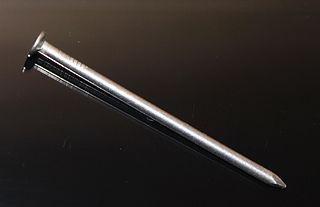
In woodworking and construction, a nail is a small object made of metal which is used as a fastener, as a peg to hang something, or sometimes as a decoration. Generally, nails have a sharp point on one end and a flattened head on the other, but headless nails are available. Nails are made in a great variety of forms for specialized purposes. The most common is a wire nail. Other types of nails include pins, tacks, brads, spikes, and cleats.

A suspension bridge is a type of bridge in which the deck is hung below suspension cables on vertical suspenders. The first modern examples of this type of bridge were built in the early 1800s. Simple suspension bridges, which lack vertical suspenders, have a long history in many mountainous parts of the world.

Lumber is wood that has been processed into dimensional lumber, including beams and planks or boards, a stage in the process of wood production. Lumber is mainly used for construction framing, as well as finishing. Lumber has many uses beyond home building. Lumber is sometimes referred to as timber as an archaic term and still in England, while in most parts of the world the term timber refers specifically to unprocessed wood fiber, such as cut logs or standing trees that have yet to be cut.

Stairs are a structure designed to bridge a large vertical distance between lower and higher levels by dividing it into smaller vertical distances. This is achieved as a diagonal series of horizontal platforms called steps which enable passage to the other level by stepping from one to another step in turn. Steps are very typically rectangular. Stairs may be straight, round, or may consist of two or more straight pieces connected at angles.
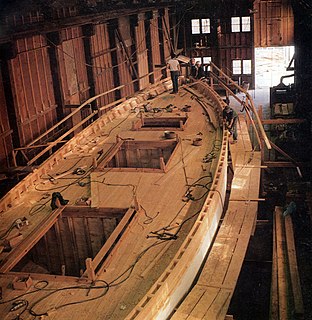
Boat building is the design and construction of boats and their systems. This includes at a minimum a hull, with propulsion, mechanical, navigation, safety and other systems as a craft requires.

In architecture, a deck is a flat surface capable of supporting weight, similar to a floor, but typically constructed outdoors, often elevated from the ground, and usually connected to a building. The term is a generalization from the deck of a ship. A level architectural deck may be intended for use by people, e.g., what in the UK is usually called a decked patio. "Roof deck" refers to the flat layer of construction materials to which the weather impervious layers are attached to a form a roof. It is known as the "roof deck", and they may be either level or sloped.

Spark testing is a method of determining the general classification of ferrous materials. It normally entails taking a piece of metal, usually scrap, and applying it to a grinding wheel in order to observe the sparks emitted. These sparks can be compared to a chart or to sparks from a known test sample to determine the classification. Spark testing also can be used to sort ferrous materials, establishing the difference from one another by noting whether the spark is the same or different.

Wood-plastic composites (WPCs) are composite materials made of wood fiber/wood flour and thermoplastic(s) such as polythene (PE), polypropylene (PP), polyvinyl chloride (PVC), or polylactic acid (PLA).

A utility pole is a column or post typically made out of wood used to support overhead power lines and various other public utilities, such as electrical cable, fiber optic cable, and related equipment such as transformers and street lights. It can be referred to as a transmission pole, telephone pole, telecommunication pole, power pole, hydro pole, telegraph pole, or telegraph post, depending on its application. A Stobie pole is a multi-purpose pole made of two steel joists held apart by a slab of concrete in the middle, generally found in South Australia.

Falsework consists of temporary structures used in construction to support a permanent structure until its construction is sufficiently advanced to support itself. For arches, this is specifically called centering. Falsework includes temporary support structures for formwork used to mold concrete in the construction of buildings, bridges, and elevated roadways.
A tie, strap, tie rod, eyebar, guy-wire, suspension cables, or wire ropes, are examples of linear structural components designed to resist tension. It is the opposite of a strut or column, which is designed to resist compression. Ties may be made of any tension resisting material.

Guard rail, guardrails, or protective guarding, in general, are a boundary feature and may be a means to prevent or deter access to dangerous or off-limits areas while allowing light and visibility in a greater way than a fence. Common shapes are flat, rounded edge, and tubular in horizontal railings, whereas tetraform spear-headed or ball-finialled are most common in vertical railings around homes. Park and garden railings commonly in metalworking feature swirls, leaves, plate metal areas and/or motifs particularly on and beside gates.
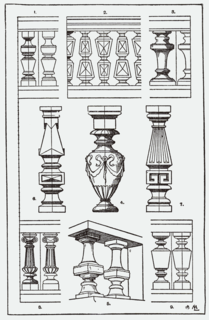
A baluster is an upright support, often a vertical moulded shaft, square, or lathe-turned form found in stairways, parapets, and other architectural features. In furniture construction it is known as a spindle. Common materials used in its construction are wood, stone, and less frequently metal and ceramic. A group of balusters supporting a handrail, coping, or ornamental detail are known as a balustrade.
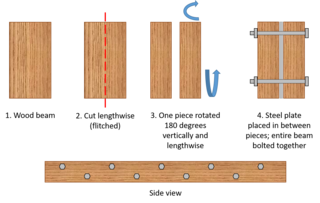
A flitch beam is a compound beam used in the construction of houses, decks, and other primarily wood-frame structures. Typically, the flitch beam is made up of a vertical steel plate sandwiched between two wood beams, the three layers being held together with bolts. In that common form it is sometimes referenced as a steel flitch beam. Further alternating layers of wood and steel can be used to produce an even stronger beam. The metal plates within the beam are known as flitch plates.[1] Flitch beams were used as a cost-effective way to strengthen long-span wooden beams, and have been largely supplanted by more recent technology.
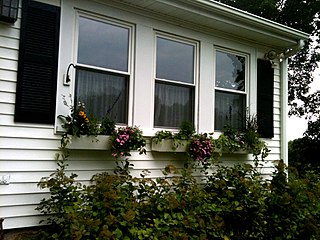
Plastic lumber is a plastic form of lumber made of virgin or recycled plastic It is mostly made of plastic and binders such as fiberglass or rebar; not to be confused with wood-plastic composite lumber. Widely employed in outdoor decking, it is also used for molding and trim and garden furniture such as park benches. Because plastic lumber displaces wood timber, it is a carbon negative and a carbon capture and utilization technology.

The set of large ornate staircases in the first-class section of the RMS Titanic, sometimes collectively referred to as the Grand Staircase, is one of the most recognizable features of the British transatlantic ocean liner which sank on her maiden voyage in 1912 after a collision with an iceberg. Reflecting and reinforcing the staircase's iconic status is its frequent, and prominent, portrayal in media.

Cast-iron architecture is the use of cast iron in buildings and objects, ranging from bridges and markets to warehouses, balconies and fences. Refinements developed during the Industrial Revolution in the late 18th century made cast iron relatively cheap and suitable for a range of uses, and by the mid-19th century it was common as a structural material, and particularly for elaborately patterned architectural elements such as fences and balconies, until it fell out of fashion after 1900 as a decorative material, and was replaced by modern steel and concrete for structural purposes.
Composite construction is a generic term to describe any building construction involving multiple dissimilar materials. Composite construction is often used in building aircraft, watercraft, and building construction. There are several reasons to use composite materials including increased strength, aesthetics, and environmental sustainability.
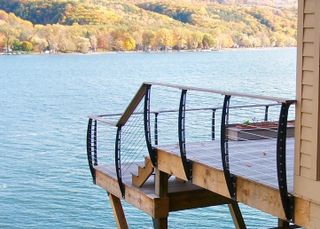
Cable railings, or wire rope railings, are safety rails that use horizontal or vertical cables in place of spindles, glass and mesh for infill.

An ironworker is a tradesman who works in the iron-working industry. Ironworkers assemble the structural framework in accordance with engineered drawings and install the metal support pieces for new buildings. They also repair and renovate old structures using reinforced concrete and steel. Ironworkers may work on factories, steel mills, and utility plants.
`